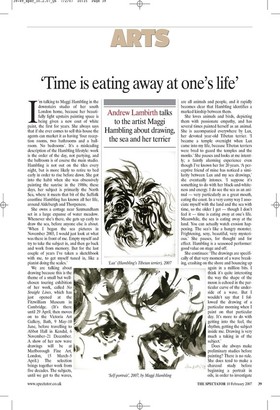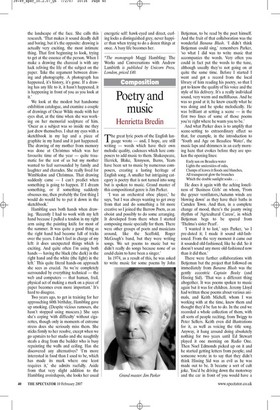'Time is eating away at one's life'
Andrew Lambirth talks to the artist Maggi Hambling about drawing, the sea and her terrier 1'm talking to Maggi Hambling in the downstairs studio of her south London home, because her beautifully light upstairs painting space is being given a new coat of white paint, the first for years. She always says that if she ever comes to sell this house the agents can market it as having 'four reception rooms, two bathrooms and a ballroom. No bedrooms'. It's a misleading description of the Hambling lifestyle: work is the order of the day, not partying, and the ballroom is of course the main studio. Hambling is not out on the tiles every night, but is more likely to retire to bed early in order to rise before dawn. She got into the habit when she was obsessively painting the sunrise in the 1980s; these days, her subject is primarily the North Sea, where it meets that bit of the Suffolk coastline Hambling has known all her life, around Aldeburgh and Thorpeness.
She owns a cottage near Saxmundham set in a large expanse of water meadow. Whenever she's there, she gets up early to draw the sea, before anyone else is about. 'When I began the sea pictures in November 2003, I would just look at what was there in front of me. Empty myself and try to take the subject in, and then go back and work from memory. But for the last couple of years I've taken a sketchbook with me, to get myself tuned in, like a pianist doing the scales.'
We are talking about drawing because this is the theme of a small but wellchosen touring exhibition of her work, called No Straight Lines, which has just opened at the Fitzwilliam Museum in Cambridge. (It's there until 29 April, then moves on to the Victoria Art Gallery, Bath, 9 May-10 June, before travelling to Abbot Hall in Kendal, 6 November-21 December. A show of her new wave drawings will be at Marlborough Fine Art, London, 15 March-5 April.) The selection brings together work from five decades. The subjects, until we get to the waves, are all animals and people, and it rapidly becomes clear that Hambling identifies a marked kinship between them.
She loves animals and birds, depicting them with passionate empathy, and has several times painted herself as an animal. She is accompanied everywhere by Lux, her devoted year-old Tibetan terrier. 'I became a temple overnight when Lux came into my life, because Tibetan terriers were bred to guard the temples and the monks.' She pauses and looks at me intently; a faintly alarming experience even though I've known her for 20 years. 'A perceptive friend of mine has noticed a similarity between Lux and my sea drawings,' she eventually intones. 'I suppose it's something to do with her black-and-whiteness and energy. I do see the sea as an animal — very particularly as a great mouth, eating the coast. In a very corny way I associate myself with the land and the sea with time, so the older I get — though I don't feel it — time is eating away at one's life. Meanwhile, the sea is eating away at the land. You can actually watch erosion happening. The sea's like a hungry monster. Frightening, sexy, beautiful, very mysterious.' She pauses, for thought and for effect. Hambling is a seasoned performer: good value on stage and off.
She continues: 'The drawings are specifically of that very moment of a wave breaking, crashing on the shore and bouncing up again in a million bits. I think it's quite interesting the way the shape of the moon is echoed in the particular curve of the underside of a wave. But I wouldn't say that I followed the drawing of a particular morning when I paint on that particular day. It's more to do with getting into the feel, the rhythm, getting the subject inside me. Drawing is very much a taking in of the subject.'
Does she always make preliminary studies before painting? There is no rule. She does tend to make a charcoal study before beginning a portrait in oils, in order to investigate the landscape of the face. She calls this research. 'That makes it sound deadly dull and boring, but it's the opposite: drawing is actually very exciting, the most intimate thing. That first beginning to look, trying to get at the essence of the person. When I make a drawing the charcoal is with any luck reliving the life of the subject on the paper. Take the argument between drawing and photography. A photograph has happened, it's history, it's gone. If a drawing has any life to it, it hasn't happened, it is happening in front of you as you look at it.'
We look at the modest but handsome exhibition catalogue, and examine a couple of drawings of Oscar Wilde made with her eyes shut, at the time when she was working on her memorial sculpture of him 'Oscar as a subject was so inside me they just drew themselves. I shut my eyes with a sketchbook in my lap and a piece of graphite in my hand and it just happened. The drawing of my mother from memory was done at Christmas which was her favourite time of the year — quite traumatic for the rest of us but my mother wanted to feel surrounded by family and laughter and charades. She really lived for Wimbledon and Christmas. That drawing suddenly came — I can't predict when something is going to happen. If I dream something, or if something suddenly obsesses me, then probably the first thing I would do would be to put it down in the sketchbook.'
Hambling uses both hands when drawing. 'Recently I had to work with my left hand because I pulled a tendon in my right arm using the painting knife for most of the summer. It was quite a good thing as the right hand had become full of tricks over the years. I don't feel in charge of my left: it does unexpected things which is exciting. And quite often I'm using both hands — having the black (the dark) in the right hand and the white (the light) in the left.' This quite literal hands-on approach she sees as crucial. 'As we're completely surrounded by everything technical — the web and computers — that human, frail, physical act of making a mark on a piece of paper becomes even more important.' It's hard to disagree.
Two years ago, to get in training for her approaching 60th birthday, Hambling gave up smoking. (Despite vicious rumours, she hasn't stopped using mascara.) She says she's coping 'with difficulty' without cigarettes, though only in moments of extreme stress does she seriously miss them. She sticks firmly to her resolve, except when we go upstairs to her studio and she naughtily steals a drag from the builder who is busy repainting the walls and ceiling. Has she discovered any alternatives? 'I'm more interested in food than I used to be, which has made its mark where one least requires it,' she admits ruefully. Aside from that very slight addition to the Hambling avoirdupois, she looks her usual energetic self: hawk-eyed and direct, curling locks a distinguished grey, never happier than when trying to do a dozen things at once. A busy life becomes her.
*The monograph Maggi Hambling: The Works and Conversations with Andrew Lambirth is published by Unicorn Press, London, priced f40.














































 Previous page
Previous page